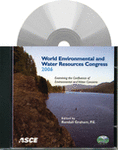Stochastic GIS-Based Water Resources/Quality Modeling of the Land Water Interface
Publication: World Environmental and Water Resource Congress 2006: Examining the Confluence of Environmental and Water Concerns
Abstract
Linking a land model to a water model at this interface is a major step in developing an integrated water quantity/quality modeling process. On the other hand, the quantification of variability and uncertainty of hydrology and water quality parameters is a great challenge facing water resources managers. The objective of this paper is to.report on the use of the Gridded Surface Sub-surface Hydrological Analysis (GSSHA) and CE-QUAL-W2 model interfaces in the Watershed Modeling System (WMS) as a framework for an integrated water resources approach that can stochastically model the land water interface. The conventional integrated water resources methods are primarily based on deterministic approaches. Whereas this research uses some statistical methods to address uncertainty and account for the randomness of model input variables. WMS is a comprehensive graphical modeling environment for various phases of watershed hydrology. It is a GIS-based pre/post processing software that supports many hydrologic/hydraulic and water quality models widely used by water resources managers/engineers. GSSHA is a 2d physical, distributed hydrologic model that simulates the hydrologic response of a watershed subject to given hydrometeorological inputs. CE-QUAL-W2 is a two-dimensional water quality and hydrodynamic model capable of modeling watersheds with interconnected rivers, reservoirs and estuaries. The framework presents modeling the land portion of the watershed using GSSHA and taking the GSSHA output to use as input to CE-QUAL-W2. This process is repeatedly done using statistical simulation for GSSHA input parameters using probability density functions (PDFs) of selected parameters that are assumed to exhibit a probabilistic nature. Furthermore, the presented framework addresses uncertainty in both water quantity and quality. Statistical intervals are used to report results as opposed to single value. For example, a time series of a pollutant of choice is presented in a credible interval of, for instance, 95% confidence level would suggest there is a 95% probability that the pollutant lies between the interval limits. This is as opposed to reporting a single concentration value for each time step.
Get full access to this chapter
View all available purchase options and get full access to this chapter.
Information & Authors
Information
Published In
Copyright
© 2006 American Society of Civil Engineers.
History
Published online: Apr 26, 2012
ASCE Technical Topics:
- Engineering fundamentals
- Environmental engineering
- Hydrologic models
- Infrastructure
- Land use
- Mathematics
- Models (by type)
- Parameters (statistics)
- Probability
- River engineering
- River systems
- Statistics
- Stochastic processes
- Two-dimensional models
- Urban and regional development
- Urban areas
- Water and water resources
- Water management
- Water policy
- Water quality
- Water resources
- Water treatment
- Watersheds
Authors
Metrics & Citations
Metrics
Citations
Download citation
If you have the appropriate software installed, you can download article citation data to the citation manager of your choice. Simply select your manager software from the list below and click Download.
